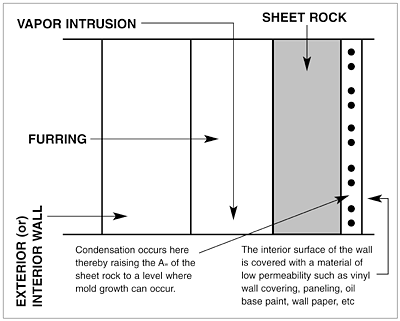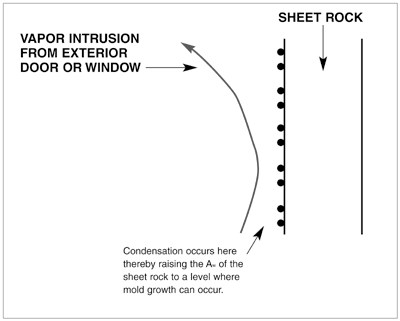
The Four Fundamentals
As we know, mold and fungi in a building can cause air quality problems so serious that the health of occupants is endangered, and on occasion entire buildings have been vacated until the condition could be corrected. Quite expensive retrofits to make these buildings usable again are also not uncommon.To understand how building systems can be the cause or the cure of the mold problem, we must first take a look at the four conditions necessary for mold's formation and subsequent growth.
Temperature. The temperature must be between 40°F and 120°F. This condition exists in every building.
Spores. There must be mold spores to start the growth. These exist almost everywhere and gain access to the inside of a building through the opening of doors, outside air intakes, cracks, crevices, and even on clothing.
Moisture. Mold requires moisture to form and grow. Mold cannot extract moisture from the air and must obtain the necessary moisture from the substrate (such as gypsum wallboard) on which it lives.
Nutrients. Mold requires nutrients to form and to exist. These nutrients are omnipresent in a building and consist of the most basic of materials such as dust, paper, glue (it loves glue), dirt, wood products, and other organic matter. Mold will destroy the substrate on which it lives.
If any one of these four conditions is absent, mold cannot start and cannot exist. It becomes subsequently obvious from reviewing these four conditions that the only one that can be contained by the building systems is moisture.

Water Formation
As mentioned, mold cannot extract moisture from the surrounding air, and so it must obtain this water from the substrate. It's easy to understand how the substrate can be dampened by water from exterior wall leaks, parapet leaks, roof leaks, plumbing leaks, condensation dripping from ducts, and chilled water lines. Other, more insidious factors are more complex and more difficult to isolate as the cause of mold growth.Mycologists seem to agree that the best yardstick to measure the moisture level in the substrate is the term water activity (Aw), also designated as equilibrium relative humidity (ERH). Aw is equal to the vapor pressure of the water in the substrate (Ps) divided by the saturation vapor pressure of water (Pw) at the same temperature:
Aw = Ps ÷ Pw = ERH
Some research suggests that the value of Aw adequate to encourage mold germination and growth may be as low as 0.69, but it is generally considered to be about 0.8. This means that continuously high room rh without the presence of "free water" can cause mold growth. There is an interchange of moisture between the substrate surface and the surrounding air until an equilibrium is reached.

Moisture Substrate
Moisture in the substrate can be caused by very high room rh, but it should also be pointed out that the higher the rh (at the same db temperature) in a room, the higher the dewpoint in that room. This, of course, can cause condensation to occur, and resulting drips from the cold surfaces of ceiling diffusers, registers, improperly insulated cold ducts, and chilled water piping.However, mold growth simply from high rh does not appear to cause problems very often, and most of those problems commonly observed may also stem from instances where some form of air economizer (classroom unit ventilators and economizers on rooftop units) malfunctions by admitting more outdoor air than the unit could dehumidify.
There are many reasons why water vapor in the air condenses on the substrate. The following examples use sheet rock as the substrate because it is the most widely used material found in building interiors.
In the first example (Figure 1), rain falling on the exterior wall moves into the wall by capillary action. When the rain stops, the sun shines and raises the vapor pressure (and thus the dewpoint) of the incoming moisture, causing condensation behind the wall covering. Negative pressure makes this condition more likely to occur. This condition can also occur when irrigation sprinklers strike the exterior wall.
The second case (Figure 2) involves a ventilated attic space and an ongoing negative pressure, caused by constantly running exhaust fans extracting more air from the building than the ahu's are introducing into the building. This condition is very possible in buildings where multiple, constantly running toilet exhaust fans are installed. When it happens, mold can be seen around electrical receptacles and strobe fire alarm lights, and fluorescent fixtures sometimes show visible water.
Figure 3 illustrates a scenario common to motels where constantly running toilet exhaust fans create a constant negative pressure on the room, and the room is being maintained at a temperature below the dewpoint of outdoor air. It also occurs in the foyers of large buildings, causing dripping from the cold surfaces of ceiling diffusers and supply registers.
The Role Of Mechanical Systems In mold Growth
When a building is maintained at more than 65% rh, there is one dominant cause for mold: more untreated outdoor air is entering the space than the system can consistently and effectively dehumidify.When there is mold growth in a building caused by the mechanical system, problems result from one or both of these scenarios: free water formed by condensation, and/or high (at least 65%) rh.
Condensation And Building Pressurization
Condensation in a building can form with the help of one or both of these culprits:
- Condensation of room air. This occurs when high humidity in the space comes in contact with cold surfaces, such as supply diffusers and registers, or with improperly insulated cold pipes or ducts.
- Condensation of infiltrating outdoor air. This occurs when vapor-laden outdoor air, infiltrating for any reason, comes in contact with cold room surfaces that are at a temperature below the dewpoint of outdoor air.
Building pressurization is a function of the design and control of the building's mechanical system, and it should always be in slightly positive relation to the ambient atmospheric pressure. This positive pressure must be accomplished in the design and control of the mechanical air-handling and exhaust fans. This is done by designing the inflow of outdoor air to the air-handling system to be about 20% greater than the outflow of air to the atmosphere by the exhaust fans.
Too much positive pressure in a building wastes energy and often denotes that the air-handling system is bringing in more outdoor air than the ahu can effectively dehumidify. Conversely, negative pressure in a building is often a precursor of mold growth and should not be continued.
Design, Construction, And Operation Tips
In closing, the following tactics should be given special consideration in the effort to avoid mold problems.
- Design the system so that the building operates under a slight positive pressure. In multistory buildings, each floor should be considered separately.
- Avoid the use of continuously operating exhaust fans. Use small fans, controlled by light switches, for small toilets. Use motion detector control for large toilet/locker rooms.
- Design the air-handling systems to have the capability to remove the required amount of moisture under part- and full-load conditions. Where the outdoor air being drawn into the ahu exceeds 15% of the supply air, or where there are high interior moisture gains, use some method of dehumidification enhancement method.
- Be careful of large kitchen hoods; they are frequently the cause of negative pressure in a building. Use compensating hoods and supply fans to provide at least 80% of the air that a hood's exhaust fan withdraws. Make up the deficit with the ahu supplying conditioned air to the kitchen. Interlock the supply fans with the exhaust fans in a manner which cannot be defeated electrically.
- Avoid the use of economizers such as classroom unit ventilators or rooftop unit economizers in climates where the outdoor air ambient temperature is seldom less than 55°F.
- Carefully select the location of outdoor air intakes. Do not locate near any source of moisture, or close to roof surfaces. Do not locate where noxious fumes, such as engine exhaust, may be picked up.
- Insulation of ducts and cold piping should be sufficient to prevent condensation. Pipe hangers and duct hangers should be designed so as not to compress the insulation. All insulation should be vapor sealed, in accordance with manufacturer recommendations. Bells of ceiling diffusers should be insulated.
- Ductwork should be galvanized steel, or antifungal coated fiber duct at least 1.5 in. thick. Ductwork should be leak-tested and made tight before insulation is applied.
- Inside temperatures should not be maintained below the dewpoint of the outdoor air surrounding the building.
- In apartment houses or hotels with interior corridors, a 100%-outdoor-air unit should supply air to the elevator lobbies or corridors to make up for air exhausted from the toilet rooms and/or kitchens. ES
